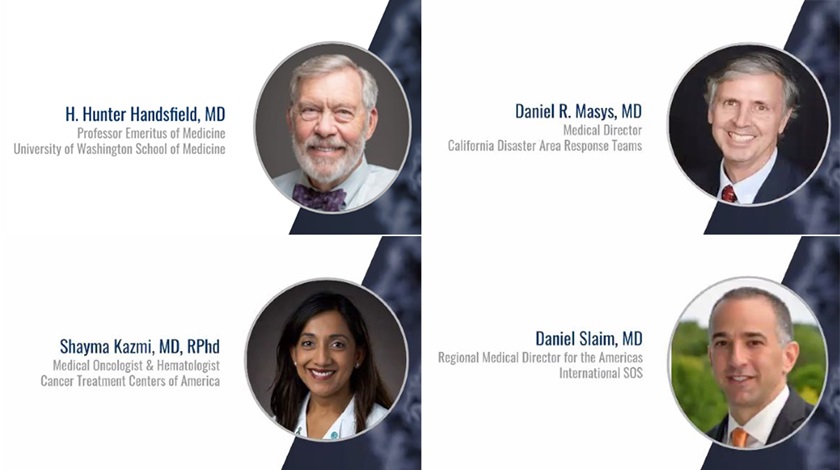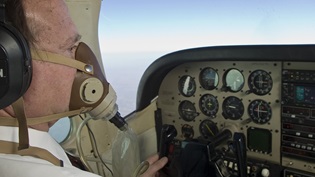Doctors refine advice to volunteer pilot groups
Patient needs may justify coronavirus risk in some cases
Volunteer medical transport flights have been curtailed for months in keeping with social distancing advisories, but as states begin to ease restrictions on the general population, physicians advising the Air Care Alliance said that resumption of high-priority flights may be indicated, with appropriate precautions and a mission-specific risk assessment.

Four physicians (including two who are active general aviation pilots) briefed participants in a May 4 webinar hosted by the Air Care Alliance. They advised volunteer pilot organizations and individual pilots to consider the ongoing pandemic as a set of risk factors to be weighed in much the same way as weather, aircraft condition, and pilot fitness before flight.
“I put this in the context of pilot in command responsibilities,” said Dr. H. Hunter Handsfield, a professor emeritus at the University of Washington School of Medicine, and a longtime volunteer pilot with (and past board member of) Angel Flight West. “We now need to add coronavirus prevention as another PIC responsibility.”
Various GA groups that specialize in humanitarian transportation of patients who might otherwise be unable to access advanced care for cancer and other illnesses are considering when and how to resume operations. Physicians said many of the patients served by these groups cannot afford to wait until the coronavirus risk subsides.
The medical advice was provided in the context of urgent needs, though much of it is broadly applicable to GA operations. The physicians suggested that organizations and pilots should weigh the importance of making any given flight against the known risks—including the prevalence of COVID-19 at each location where a given flight will connect.
Handsfield and Dr. Daniel Masys, a Van’s Aircraft RV–10 owner who also advises volunteer pilot organizations, each updated the guidance they previously provided to the Air Care Alliance in March, when the risks were considered too high to justify continuation of medical transport flights.
There now appears to be some room for high-priority flights, with a nuanced assessment of risks. Physical separation is never assured in typical GA aircraft, particularly nonpressurized aircraft often flown by volunteers. Patients known to be infected, those who have come in contact with people known to be infected, or anyone with any respiratory symptoms should not fly with others in small aircraft, the physicians advised in the May 4 webinar, as well as in updated written guidance that Handsfield and Masys each posted online. Pilots who are among those at higher risk from the coronavirus based on age or certain medical conditions take on significantly greater risk to themselves if they fly common GA aircraft with others.
Handsfield favors consideration of flight requests on a case-by-case basis, rather than any blanket policy applied to all. He also noted that the latest available evidence and data suggest simple face masks may offer more effective protection than many experts initially expected.
“In my personal opinion, volunteer pilot organizations and others should not have restrictions that are more stringent than those that otherwise apply to the people they serve,” Handsfield said, noting that as states relax stay-at-home and related advisories, many health care providers are already following suit and resuming nonemergency medical care and procedures.
Back in February and March, as states began to issue more restrictive social distancing advice and mandates, the details of exactly how the coronavirus, named SARS-CoV-2, infects people were presumed rather than proved.
“Now, I think we have confidence that the major mode of transmission of the virus is person to person, via respiratory pathways,” said Masys, a former U.S. Navy doctor, federal public health officer, and the current medical officer for the California Disaster Airlift Response Team.
Masys said it now appears likely that transmission of the virus between people usually results from comparatively large droplets of fluid being expelled when an infected individual coughs, sneezes, or talks. (Exposure and infection are not the same thing, and it remains unknown how duration of exposure, or the amount of virus transmitted, affects the severity of illness.) Smaller, finer, aerosolized fluids (tiny droplets of fluid that, by definition, remain airborne for some time) are less likely to cause infection, though aerosol exposure is not risk-free.
That could shift the risk analysis for a given flight, making the risk posed by COVID-19 more akin to the risk of flying through low IFR over mountains than the risk posed by supercell thunderstorms over the airport.
Masys noted that aeronautical decision making for pilots and GA organizations would be much easier if rapid and accurate tests for the virus were widely available. Passengers and crew alike could then be screened for infection definitively, immediately prior to departure.
“In the absence of that capability, a simple formula for knowing it is acceptable to conduct passenger operations, based on some set of quantitative measures such as current known prevalence of COVID-19 in a region or trends in new cases, does not appear to be in hand at this time, or available for the foreseeable future,” Masys wrote.
Dr. Daniel Slaim, regional medical director for the Americas at International SOS, expressed optimism that such on-demand, rapid testing will be available soon.
“When that comes then the whole calculation will change as well,” Slaim said, adding that reliable testing for antibodies and the ability to assess prior exposure and immunity, which may or may not exist for those who have recovered from an infection, will also simplify what are currently very complex and nuanced risk assessments.
In the meantime, screening passengers for fever, respiratory symptoms, and recent exposure (within 14 days) to anyone known to be infected, along with frequent hand-washing, avoidance of physical touching, and facial coverings (including surgical masks), combined with what is still a relatively low prevalence of known COVID-19 infection in the population, “probably provides a high degree of safety” for resumption of patient transport flights, Handsfield said. However, "a high degree does not mean zero risk,” he warned.
For many people, seven or eight weeks of staying home to “flatten the curve” has forced them to defer urgent medical needs, including chemotherapy or other cancer treatment, increasing the risk they will suffer harm or even die from illnesses unrelated to the pandemic.
“Access to care is a big concern,” said Dr. Shayma Kazmi, an oncologist and hematologist affiliated with Cancer Treatment Centers of America. She said that a patient’s oncologist (or other treating physician) will have a very useful perspective on the risk-benefit analysis that pilots and medical organizations now need to undertake on a case-by-case basis when deciding whether to dispatch a flight. Consulting the treating physician during the decision-making process, and documenting that decision, including the factors considered, would provide a level of reassurance, she added. “I think everyone might be better protected.”




